VENEZUELA April 23 – May 7, 2012
Venezuela is about twice the size of California with 27 million people. Columbus was the first European to set foot in Venezuela which means ‘little Venice’ as the indigenous people were living in thatched huts built on stilts over the water. Simon Bolivar was born in Caracas and was responsible for the liberation of almost all of S America by 1830. Oil was discovered in 1910 and V. was the world’s largest oil producer in the 1920’s. Fast money has led to the neglect of agriculture and manufacturing and Venezuelans import most everything. Government had a series of dictators and civil wars until 1958 when its first democratic government was elected. Chavez was elected in 1994 and has granted himself sweeping powers, he changed the constitution in 1996 allowing indefinite election and was reelected in 2006. Chavez has severely limited radio and TV criticism and the billboards and TV constantly show propaganda – all his supporters wear red. His slogan – “Integration y Progreso” is everywhere. He has introduced many programs for the poor like better medical service and education but ⅓ are still in poverty. This along with crime and high inflation remain major concerns. Garbage disposal is a big issue and it is everywhere. Chavez was in Cuba getting treatment for a cancer which does not say much for their medical system A policy of nationalization has scared international investment. There was an election in October 2012 and the more well off were keen to get rid of him over corruption and a system that is not working. He eventually died shortly after his 2013 reelection – he was not well enough to get inaugurated. 70% are of mixed race, 20% white and 6% black with 3% indigenous. Venezuelan women have won more beauty pageants than any other with 5 Miss Worlds and 6 Miss Universes. Baseball, basketball and football are the main sports. It has the Amazon, the Orinoco River (it’s 2150 km is entirely within Venezuelan), the Andes, savannahs, beaches (2150 km of Caribbean coast), jungles, and great animal diversity. The wet season is from May to October. Gas is 3 cents a litre, about 1/50 the price of bottled water.
I flew on the 23rd to Caracas on a relatively cheap flight with two stops – Sao Paulo and Bogota for a 17 hour day. The views of Rio from the air were outstanding as were all the views of the coast south of the city including Ilha Grande. Sao Paulo is truly gigantic from the air. Leaving the airport for a walk outside required paying a $35 re-entry fee so I didn’t. Arriving in Bogota was so nice and it felt good to be in a Spanish-speaking country again. I found Brazilians not that friendly and it was very expensive especially staying in Ipanema. It was interesting to see again how mountainous and green Colombia is. My flight landed in Caracas after midnight and as my flight to points east was at 8 AM and hotels near the airport were incredibly expensive (cheapest was $260 US per night), I slept in the airport on the floor at the food court. It was quite comfortable. As the official exchange rate for Venezuelan Bolivars is 4.3 to the $US and the black market rate is 8 or 9 to the $US, I entered Venezuela with $1300 US in my pocket. One pays for little (except tours) with $US until you exchange it on the black market which was easy to do (one must beware that this is illegal and counterfeit money is supposedly common). Don’t use credit cards or debit cards as they remove Bolivars at the official rate. $US are popular as Venezuelans cannot obtain them in the country and they are a great hedge against inflation. Taxis and food are expensive. Basically everything is paid for at the black market rate.
LA GRAN SABANA. (English: The Great Savanna) is a region in southeastern Venezuela, part of the Guianan savanna ecoregion.
The savanna spreads into the regions of the Guiana Highlands and south-east into Bolívar State, extending further to the borders with Brazil and Guyana. The Gran Sabana has an area of 10,820 km2 (4,180 sq mi) and is part of the second largest National Park in Venezuela, the Canaima National Park.
The location offers one of the most unusual landscapes in the world, with rivers, waterfalls and gorges, deep and vast valleys, impenetrable jungles and savannahs that host large numbers and varieties of plant species, a diverse fauna and the isolated table-top mesas locally known as tepuis.
The largest city in the area is Santa Elena de Uairén, which has experienced very rapid growth, with a population of over 30,000 inhabitants. It was founded in 1923 by Lucas Fernández Peña, attracted by the growth of diamond production in the area. It is 910 meters (2,990 ft) above sea level, is 15 kilometres (9.3 mi) from the border with Brazil and about 1,400 kilometres (870 mi) from Caracas, by a paved road. The total population of the Gran Sabana is currently estimated at about 48,000.
Geology. The Gran Sabana formed atop the Precambrian Guyana Shield, with the bedrock consisting of the Roraima Group, presumed to be 1.8-1.4 Ga in age. Within this Group is the resistant Mataui formation, which forms the tepui cliffs and summits. The formation is 600-900 m thick and consists of quartzite, and quartzite arenites. Tepui summits are 900 to 1600 m above the surrounding terrain. High precipitation combined with the long period of weathering has produced quartz and sandstone karst features. These include arches, towers, tower fields, dolines, collapse shafts, polje, corridors, grikes, and large cave systems extending many kilometers in length. The Roraima Sur-Los Ojos de Cristal cave system is 10.8 km long and up to 20 m in diameter.
This region was subjected to several periods of uplift and subsidence and were subjected to variable erosion. The large remaining isolated sandstone beds are called “tepuis” in the language of the indigenous inhabitants of the region. The formation of rocky and sandy soils support a savanna vegetation on the higher elevations with dense jungle vegetation occurs in depressions and dense forests along the rivers.
Tepuys. In the Gran Sabana, there are randomly distributed ancient massifs eroded in tabular form, known as tepuis. These are examples of inverted relief, which form a kind of typical plateau of the Guiana highlands. These plateaus, in the Gran Sabana, reach their maximum altitude in the Tepui Roraima, with nearly 2,800 meters (9,200 ft) above sea level.
Auyantepui. Although the Auyantepui is not part of the Gran Sabana as the exact delimitation of the territory, it is considered by many to be part of it, being the most famous tepui throughout Guiana. It is in the Canaima Northwest and is one of the most recognized tepuis in the world, because it comes from the highest waterfall in the world, the Angel Falls with an almost 979-meter (3,212 ft) freefall.
These Falls were discovered by the explorer aviator Jimmy Angel in 1937. He attempted to land his plane on top of Auyantepui, crashing (without fatalities) in one of his expeditions. It is the second largest Guiana tepui, with its surface of 700 km2 (270 sq mi), after Chimantá. It has an altitude of 2,535 meters (8,317 ft). The Auyantepui is inclined on its surface: on the southern edge it exceeds 2,400 meters (7,900 ft), while the northern edge is barely 1,600 meters (5,200 ft) high.
Mount Roraima is the highest tepui of the National Park. It is also known as Blue Mountain or Crystal Mountain, and is considered by the local indigenous population as a divinity. The Pemon believe that most tepuis host powerful spirits or entities to which they respect and fear. Some of them even make offerings and prayers at the top in their infrequent visits to the tepui (usually as tour guides in exchange for money and/or food). Its height is about 2,800 meters (9,200 ft), it covers an area of 15 km (9.3 mi) long and its surface is 200 km2 (77 sq mi). Its walls, completely vertical, may reach 500 meters (1,600 ft) high.
Despite this, over this wall, it is an outstanding area, with tilt and space for tourists to climb to the top. Among the attractions are the Valley of the Crystals (a deposit of quartz formations), the Jacuzzi area (where water wells of greenish-yellow color), the viewpoints of La Ventana and El Abismo, the North Mazes, la Proa, Lake Gladys, and the “Triple Point”. This point is in the northeast of the tepui, and is the place where it meets the border between Brazil, Venezuela and Guyana. They are also very attractive rock formations eroded by wind, leading to myriad interpretations of figures, as the formations of the “flying turtle”, the “Mexican hat”, the “monkey eating an ice cream cone,” or the “elephant”, shown in the image.
I flew 1 hour to Puerto Ordaz on the border of Guyana and then bussed 1 ½ hours to Ciudad Bolivar staying at Gekko Tours who have organized both my trips. I flew in a very slow tiny Cessna 172, 1 ½ hours south to air access only Canaima (pop 1,200). It is a very cute town with dirt streets on the edge of a big lagoon lined with a series of big waterfalls.
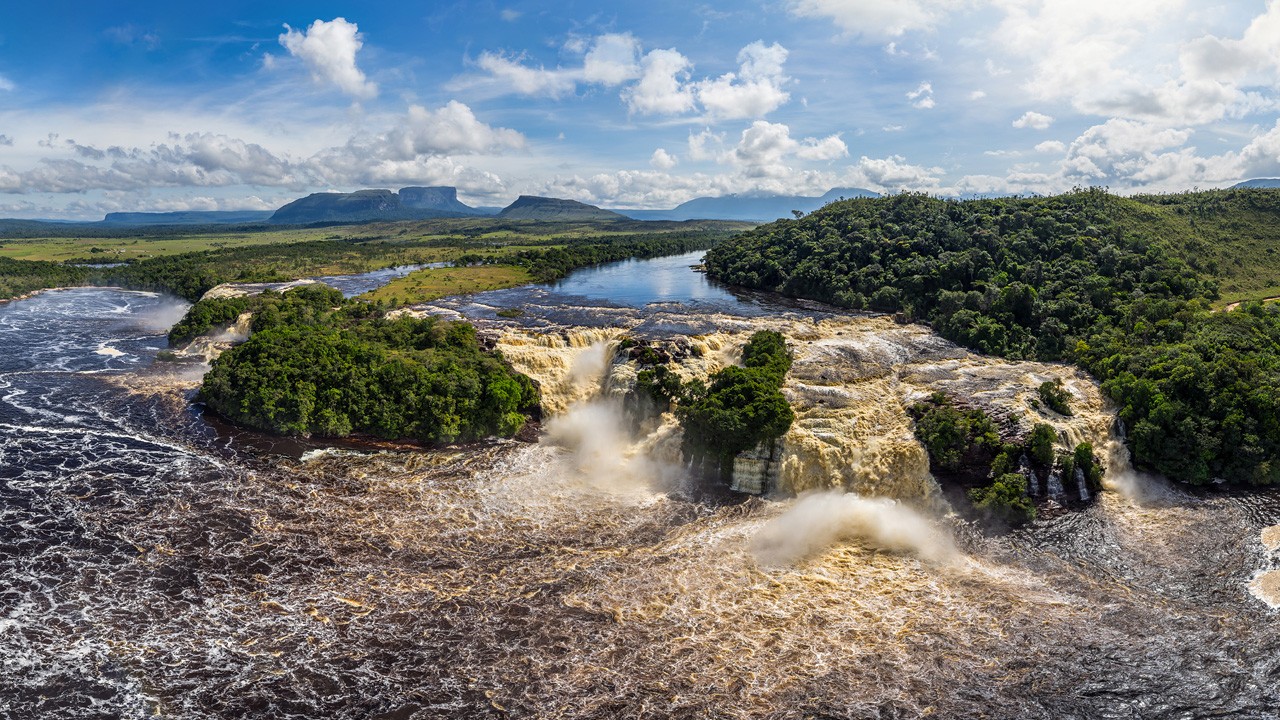
We left soon after on a boat out onto the lagoon for close-ups of the 6 large waterfalls, a mini version of Iguazu. Walking on top over some dry river beds, we went swimming in some beautiful pools, and then came down to walk behind the biggest waterfall. It was at least 80 m on a rock walkway under a large overhang. This was one of the most amazing experiences as the falls were huge with lots of spray.
The next day we drove to above the falls and boarded a long narrow dugout canoe. There were 3 German guys, a Norwegian and a French woman for the 5 hour river trip to a camp near Angel Falls, the highest waterfall in the world at 979 metres. As it is still dry season, the coca cola coloured water in the river was quite low and the skill of the boat driver negotiating all the rapids was very special. Through jungle, the riverbank was full of cobble beaches.
The landscape must be one of the most spectacular on earth as we traveled around huge mesa like tablelands called tepui with 600-900 m high vertical cliffs and a few waterfalls. The yellow/pink sandstone is 2 billion years old and through water erosion forms these huge individual mesas with their massive cliffs. There are 100 tepuis across Venezuela and most are in the east. Taking a smaller tributary, the river became progressively narrower, and the rapids more frequent. One area had huge boulders in the river. After arriving at the jungle camp, we immediately hiked 45 minutes up to the base of the falls. Falling from the edge of the tepui, the water hits terminal velocity ⅓ of the way down and is mist the rest of the way.
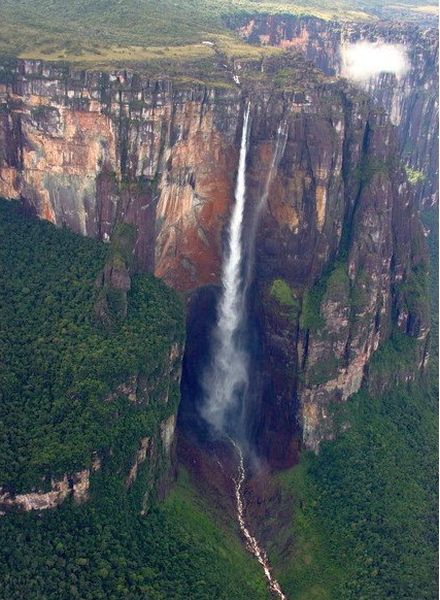
We swam in a pool under a lower waterfall. Sleeping in hammocks, it rained all night and the falls were invisible in the cloud the next morning. The river was now at least a metre deeper and the trip was at high-speed ride taking only 3 hours back (including an hour hike around rapids like on the way up). I then flew back to Ciudad Bolivar in a Cessna 184 and spent the afternoon around the pool at our posada before catching the 12 hour bus south to Santa Elena and the next adventure. The 3 young German guys and the French girl are continuing on with me.
After a day off in Santa Elena (pop 18,500), we drove 2 hours NE via San Francisco to Paraitepui to start the 6 day trek up Roraima, the only tepui easily climbed.

We had a great group of strong walkers. Hiking for about 3 ½ to 4 hours per day for 2 days we arrived at the base camp under the huge 600 m sandstone cliff. Now rainy season, it rains often every day and the cheap umbrella I bought in Santa Elena was a godsend. On the 3rd day we climbed about 900 m up the steep trail, walking through 2 waterfalls, to reach the top of the tepui. It is a surreal moonscape with all the normally pink to yellow sandstone a deep black from a coating of cyanobacteria. Rudimentary walking routes wear off the black coating exposing the pink of the ancient heavily eroded sandstone. It is an amazingly landscape with few distinctive landmarks. It is very easy to get lost and the guides were indispensable. There are buttes, creeks, marshes, small lakes, pink ‘beaches’ and low plants (some endemic to the top of Roraima and some carnivorous). Beds of crystals are everywhere but packs are checked on the way out to make sure none are taken.
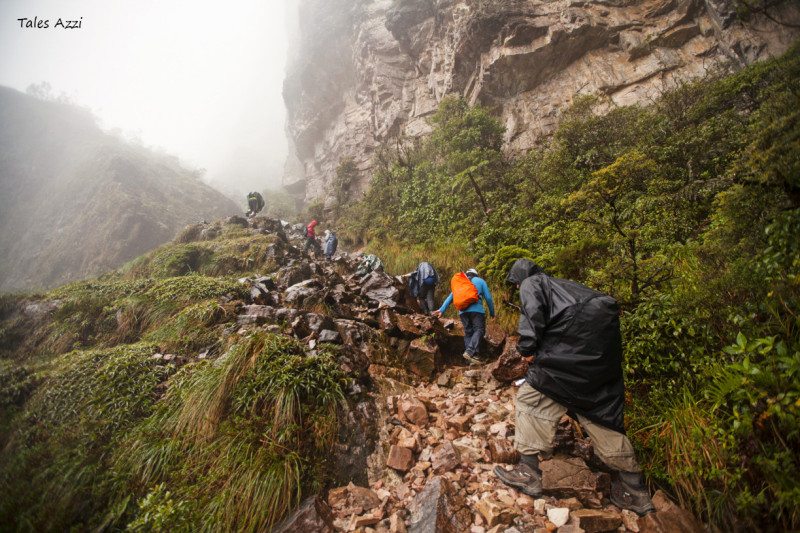
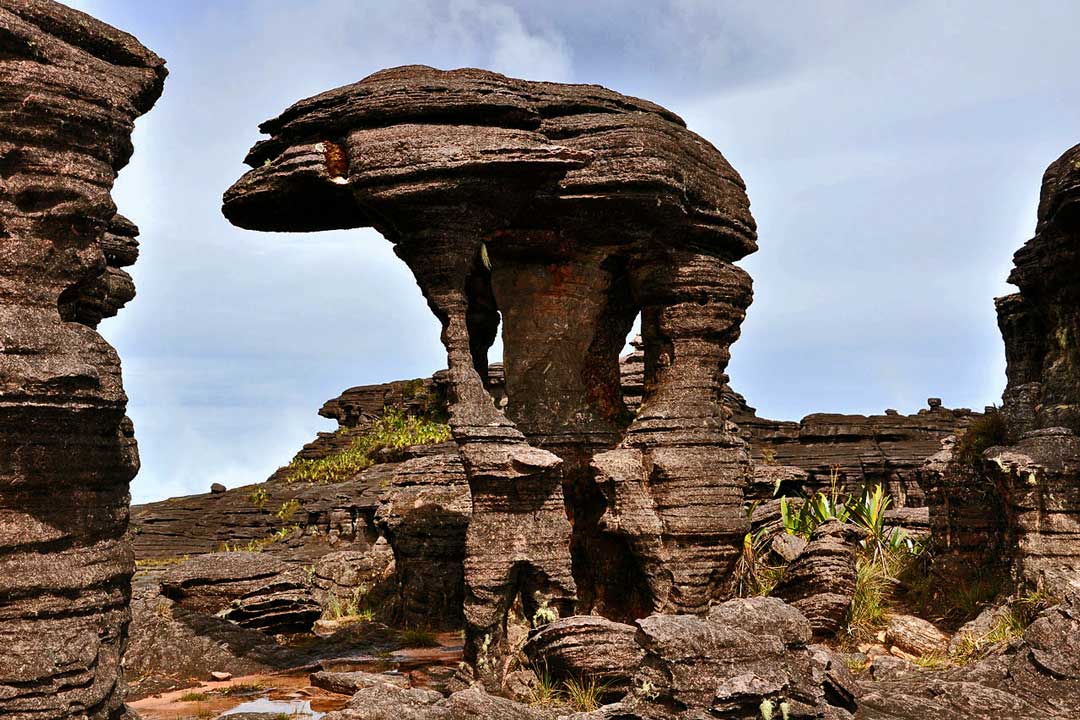

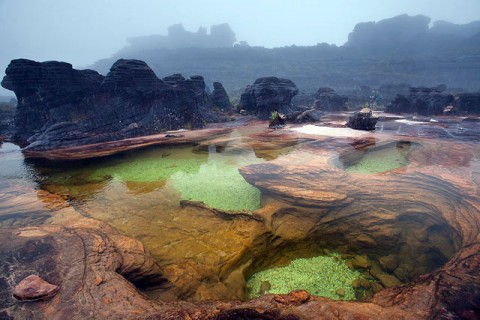
The only animals beside a few birds are tiny black frogs with an orange belly (very similar to ones in Africa and it is presumed they are related and date back 150 million years to Godwana when all the continents were joined). The weather changes fast and one sees cloud, mist, heavy rain, wind, cold, and bright sunshine all in the space of an hour.
We camped for 2 nights in one of the ‘hotels’, areas under big overhangs that offer protection from the frequent rain. On the first day we hiked to the eastern area of the top to have spectacular, though brief views for hundreds of miles into the jungle of western Guyana. We saw the tourist sites of the Window (a huge sandstone boulder tipped giving views straight down the cliff), the Jacuzzi (pretty pools lined with quartz crystals where many swim) and sitting on the edge of the 600 m vertiginous cliff. With the whole second day on top, trips normally go 9 km out to Triple Point, the spot where Guyana, Brazil and Venezuela meet. On the way are Crystal Valley and the Pit, a large sinkhole. The guides are not keen to do it if the weather is not good and we were in the cloud and rain. Instead we went to a great sandstone cave with a running stream. Down several hundred metres, with all the headlights off and the rushing water, it was a very meditative experience in the pitch black. Day 5 was the steep descent of about 6000 vertical feet down the cliff, past base camp to our campsite on the first night. On day 6, it was a long 3 ½ hour trek in the rain through hilly country with many creek crossings. The clay based soil was slick and most everybody fell once. A few pounds of clay weighed down each shoe. This trail was best described as sticks like glue, slides like snot.
After 2 days in Santa Elena to allow my quads to recover from the big descent, I caught a night bus back to Puerto Ordaz, a 10 AM flight to Caracas and then the afternoon flight to Miami for an overnight. Then Dallas and Vancouver.
Cost of Venezuela. 15 days, $1250 = $83.33/day
December, 2014. The price of oil has dropped to $68 per barrel. The annualized inflation rate of Venezuela has increased to 60% deepening the recession in the country and causing revolts. This country is a mess.
July, 2015. It doesn’t take long for things to turn very sour. This month Venezuela’s currency, the bolivar, passed a melancholy milestone: its value on the black market in now a hundredth of what it is supposed to be a the main official exchange rate. The government insists that there are 6.3 believers to the dollar, but it will cost you 630 to buy one from a willing seller. As the country’s stock of hard currency shrinks and the central bank prints money to plug a huge budget deficit, the bolivar’s collapse is accelerating. It is worth a thousandth of what it was in 1999, when Hugo Chavez came to power.
The country may be on the verge of hyperinflation. Mose economists reckon that the inflation rate is already 120% a year (the central bank stopped publishing price data, so no one is sure). Some expect it to reach 200% by the end of 2015. The government uses a labyrinthine system of price and exchange controls to shield Venezuelans from soaring prices/ But these make matters worse. Price ceilings have devastated local production, factories are operating half-capiacity and more than two0thirds of fold is imported. Affordable goods are in short supply.
With a dollars worth of believers, you can in theory by 33kg of maize flour, the national staple. But only if you can find a supermarket that has some and you are willing to queue for hours (repeatedly, since flour is rationed). For the same price, consumers could fill the tank of the family car 140 times with subsidized petrol. That amount of fuel is worth %5,000 across the border in Colombia and enterprising Venezuelans smuggle it across.
Venezuelans check prices on the twitter account of DolarToday, a Miami-based outfit which publishes updates based on transactions in the Colombian border town of Cucuta. This is where Colombians go to exchange pesos for bolivars, often to buy cheap fuel and other price-controlled goods in Venezuela for smuggling across the border. Transactions are few; the dollar rate is calculated indirectly, from the value of the Colombian peso. The result is erratic, but more realistic than the tree official rates. Although it is illegal, many Venezuelan retailers mark prices based on deals struck in the Colombian backwater. The government calls the website a conspiracy to sabotage the economy and has tried repeatedly to block it. It has called on all Venezuelans to ignore all unofficial rates – and presumably also the law of gravity.
The spiral of inflation and poverty will be resolved only when Mr Maduro reforms the economy by reducing the deficit, overhauling the state-owned oil company and eventually dismantling exchange controls. But he is likely to balk at the short-term pain such measures would cause. He is caught between a left-wing faction, that thinks the economy needs still more controls, and a military-based mafia that profits from arbitrage under the current rigged system. Poor Venezuela.
Summary of South America. I lost a ton of stuff as usual and completely wore out my flip-flops. I visited 9 countries over 6 months and saw everything on my bucket list – Colombia, Galapagos, Nasca Lines, Cusco and Machu Picchu by the Inca Trail, Colca Canyon, Atacama Desert, Easter Island, Buenos Aires, Iguazu Falls, Pantanel, Rio de Janeiro, and Angel Falls. It will be nice to be home with all its regulations, good food, and a system that works pretty well.
1 Response to Venezuela